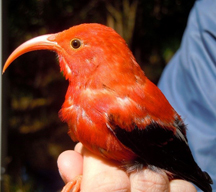Day in a Life of a Point Counter
Day in a Life of a Point Counter
By Sam Webb

There were still a few stars in the sky when I hit the trail, but the horizon was starting to lighten, and it promised another beautiful sunrise. I hiked for about 20 minutes, listening for any late owls calling or the Common Nighthawks announcing the dawn with their distinct Peent! sound. Checking my GPS, I walked another few meters before setting down my backpack and pulling gear out. Although no landmarks are around, I had just reached the first point that I will be surveying for the day.
For the past several weeks, I have been living in the gorgeous Lava Beds National Monument in Northern California to conduct avian monitoring surveys for Klamath Bird Observatory. The point that I have just stopped at is part of a point count route that has been visited every three years since 2007 as part of a collaboration between the Klamath Inventory and Monitoring Network and Klamath Bird Observatory. Point counts are a widely used method for surveying birds where observers visit specific locations or points and count every bird they detect within a standardized period of time. These surveys usually take only a few minutes to complete, meaning that observers can collect data at many locations in a single morning. Data from point count surveys are frequently used to determine changes in bird populations over time, which are often linked to environmental changes and may be used to inform land management practices.
I finished filling out the top of the data form on my clipboard, set up my timer to beep once every minute for five minutes, and positioned my binoculars to be easily accessible. Just a few moments before I began the survey, I used my laser-rangefinder to determine the distance to some of the juniper trees. Then, 15 minutes before sunrise, I hit start on the timer and began to listen intently.

All around me, the birds are waking up and starting their morning chorus songs. I furiously write down a Morning Dove that is singing near one of the trees I had measured the distance to, about 32 meters away. I watched a couple of Lark Sparrows chase each other between the rocks, and just as I finished writing them down, a Western meadowlark began its echoing song. I write almost nonstop for 5 minutes, pausing only to tune into a new song or briefly glance through my binoculars at a bright male California Quail perching on a nearby sagebrush. The timer beeps one last time at me, and the survey is done. I reviewed the datasheet before selecting the next point in the GPS and setting it off. I had 11 more points to visit and wanted to get to them before the bird activity slowed down for the day.
After reaching the 12th and final point, I perched on a rock, overviewing the valley, eating my lunch, and admiring the park. Slowly, I make my way back through each point I just visited, recording data on the habitat, identifying what shrubs and trees are present, and taking notes on the composition of forbs and grasses. When I was finally done, I reviewed the data from the day. Some highlights were a pair of Bullock’s Orioles that were busily weaving together their nest, a stunningly brilliant Mountain Bluebird that started his song almost before any other birds were up, and a Pinyon Jay that swooped by, curious about what I was doing out there. I finished packing up and began to head back to my vehicle. Done for the day, I took my time hiking back, pausing to enjoy the park and wildlife all around me. The data I collected will be provided to the Klamath Inventory and Monitoring Network to help inform decisions on management practices so that this gorgeous park can continue flourishing and support a vast host of plant and animal life.

The Klamath Inventory and Monitoring Network is a group of six national parks in the southern Oregon and northern California region that works to provide reliable scientific information about the parks and their key resources to park managers, researchers, and visitors. More information on this program can be found here.
If you are interested in becoming a field technician for Klamath Bird Observatory, you can look at current job openings here.
To support this program and other aspects of Klamath Bird Observatory’s work, you can click here to donate.
Cover photo: Common Nighthawk by Frank Lospalluto at Lava Beds National Monument

